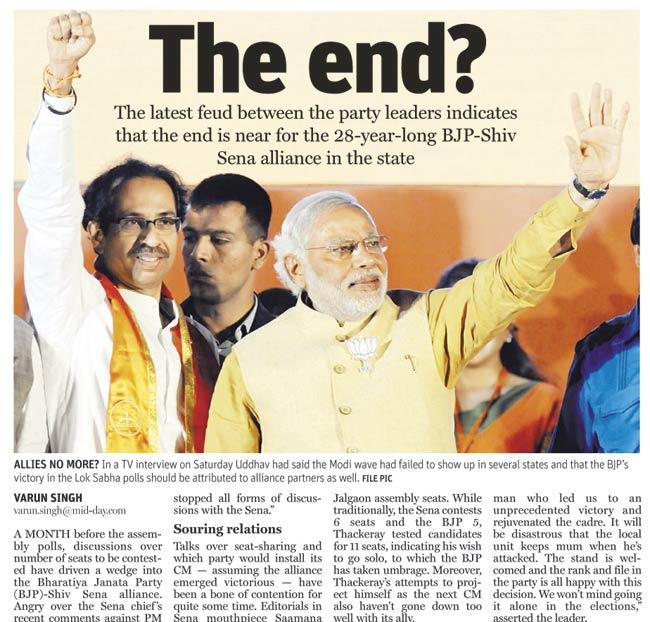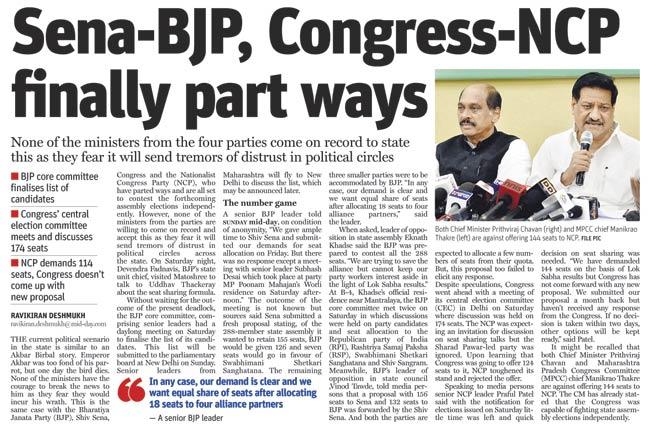It was only in 1990 that the state voted for a single party rule when the Congress, under the then CM Sharad Pawar’s leadership, thwarted a challenge from the Shiv Sena-BJP alliance, then under the late Bal Thackeray

 It was only in 1990 that the state voted for a single party rule when the Congress, under the then CM Sharad Pawar’s leadership, thwarted a challenge from the Shiv Sena-BJP alliance, then under the late Bal Thackeray. Since 1995, the state has witnessed four successive governments ruled by political alliances.
It was only in 1990 that the state voted for a single party rule when the Congress, under the then CM Sharad Pawar’s leadership, thwarted a challenge from the Shiv Sena-BJP alliance, then under the late Bal Thackeray. Since 1995, the state has witnessed four successive governments ruled by political alliances.
The developments of yesterday can clearly be termed as a win-win situation for both voters — who now have five major political parties to choose from — and the local cadres of all prominent political parties, who will work wholeheartedly for their party’s candidates.
ADVERTISEMENT

As the coalition partners went about oscillating between breaking up and kissing and making up, mid-day rode the rollercoaster with them, but we had predicted that the ride would end badly. Our reports on September 21 (left) and September 15
For the last 20 years, in one constituency, there used to be a candidate from only one party in the alliance, and political workers from both parties in the alliance had to work to promote this candidate, willingly or unwillingly. With the breaking up of both alliances having been announced formally yesterday, the belief that only coalition politics would survive and that the days of a single-party rule were over, has been disproved.

End of an era
The BJP’s 282-seat haul in the Lok Sabha elections has made not just the UPA, but also the NDA allies nervous. It’s not just coincidence that the 25-year relationship of the BJP and Shiv Sena — allies based on a common bond of Hindutva — stands annulled on September 25, the first day of Navratri, an auspicious day for Hindus.
The seeds were sown soon after the Lok Sabha results, which saw the BJP and Sena win 42 seats together. Even though the Sena touched its highest ever tally in the state — 18 seats — BJP supporters attributed this success to the ‘Modi wave’. They claimed even Sena chief Bal Thackeray couldn’t ensure so many seats during his heyday. This spoke volumes about the coalition or what was left of it.
History tells us the BJP aligned with the Sena soon after the 1988 by-election for the Vile Parle assembly seat. The Sena won it solely on the basis of Hindutva. Later, they stunned the Congress and other political parties by winning the Aurangabad Municipal Corporation polls single-handedly, strengthening the belief that if BJP wanted to grow in Maharashtra, it would have to forge an alliance with the Sena.
Accordingly, the BJP decided to accept the leadership of Bal Thackeray, who was known as Hinduhridaysamrat (emperor of Hindu hearts), at the state level. Initially, it was an unwritten pact that the BJP would take the lion’s share of the Lok Sabha seats and Sena would have an upper hand in state politics.
Soon, the tiger lunged at a bigger share of the meat six more Lok Sabha seats increasing its quota to 22 and reducing the BJP’s to 26. The BJP, assuming it to be political compulsion, swallowed the defeat and
moved on.
In the landslide victory of 2014, Narendra Modi claimed credit for winning 282 seats for the BJP and helping the allies rake in 54 seats.
The Sena was worried about the way Modi had become a Hindutva icon. The results alerted the Sena leadership that the BJP was planning to dominate it, which could prove disastrous for the party’s future.
Sena chief Uddhav Thackeray did his best to keep the morale of his party high by taking on the BJP, even though his party’s Lok Sabha performance had a lot to do with the ‘Modi wave’. As part of this strategy, he expressed his desire to become the CM, unnerving the BJP.
He then drafted a strategy to win maximum seats and launched Mission-150, staking claim to 150 seats in the state assembly. This left the BJP flabbergasted, as it was gearing up to install its own CM, with at least a dozen aspirants in tow.
The divorce had been imminent for quite some time. The Sena chief’s speech in Rang Sharda before his party office bearers proved to be the last straw that broke the camel’s back. Thackeray, while choosing to coddle the BJP in an emotional speech, took veiled potshots at them.
The picture became clear when the BJP rejected his proposal. What followed was just a charade to avoid public backlash for breaking the alliance; the meetings were purely a formality to avoid blame.
Meanwhile, the Congress and NCP, too, went their separate ways. There was unanimity among senior Congress leaders for not having any truck with the NCP, whom they consider the reason for the anti-incumbency wave. Surprisingly, NCP leader and Deputy CM, Ajit Pawar, too, was in favour of going it alone.
With the four parties attempting claw at each other’s vote share, it remains to be seen who comes out on top.
The writer is Political Editor of mid-day
 Subscribe today by clicking the link and stay updated with the latest news!" Click here!
Subscribe today by clicking the link and stay updated with the latest news!" Click here!







